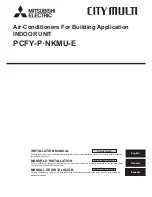
20
ENGLISH
• Make sure the headset is level and secured comfortably on your head, and that
you see a single, clear image.
• Make sure the headset and sensor cables are not choking or tripping hazards.
• Ease into the use of the headset to allow your body to adjust; use for only a few
minutes at a time at first, and only increase the amount of time using the headset
gradually as you grow accustomed to virtual reality. Looking around and using
the input device when first entering virtual reality can help you adjust to any small
differences between your real-world movements and the resulting virtual reality
experience.
• Do not use the headset while in a moving vehicle such as a car, bus, or train, as
this can increase your susceptibility to adverse symptoms.
• Take at least a 10 to 15 minute break every 30 minutes, even if you don’t think
you need it. Each person is different, so take more frequent and longer breaks if
you feel discomfort. You should decide what works best for you.
• Listening to sound at high volumes can cause irreparable damage to your
hearing. Background noise, as well as continued exposure to high volume levels,
can make sounds seem quieter than they actually are. Due to the immersive
nature of the virtual reality experience, do not use the headset with the sound
at a high volume so that you can maintain awareness of your surroundings and
reduce the risk of hearing damage.
• Serious injuries can occur from tripping, running into or striking walls, furniture
or other objects, so clear an area for safe use before using the headset.
• Take special care to ensure that you are not near other people, objects, stairs,
balconies, open doorways, windows, furniture, open flames, ceiling fans or light
fixtures or other items that you can bump into or knock down when using—or
immediately after using—the headset.
• Remove any tripping hazards from the area before using the headset.
• Remember that while using the headset you may be unaware that people and
pets may enter your immediate area.
• Do not handle sharp or otherwise dangerous objects while using the headset.
• Never wear the headset in situations that require attention, such as walking,
bicycling, or driving.
Using the device can make your muscles, joints or skin hurt. If any part of your
body becomes tired or sore while using the headset or its components, or if you feel
symptoms such as tingling, numbness, burning or stiffness, stop and rest for several
hours before using it again. If you continue to have any of the above symptoms or
other discomfort during or after use, stop use and see a doctor.
The Remote contains magnets or components that emit radio waves, which could
affect the operation of nearby electronics, including cardiac pacemakers, hearing
aids and defibrillators. If you have a pacemaker or other implanted medical device,
do not use the headset without first consulting your doctor or the manufacturer
of your medical device. Maintain a safe distance between the headset and your
medical devices, and stop using the headset if you observe a persistent interference
with your medical device.
To reduce risk of electric shock:
• Do not modify or open any of the components provided.
• Do not use the product if any cable is damaged or any wires are exposed.
• Do not use your device if any part is broken or damaged.
• Do not attempt to repair any part of your device yourself. Repairs should only be
made byan authorized servicer.
• Immediately discontinue using the headset if any of the following symptoms
are experienced: seizures; loss of awareness; eye strain; eye or muscle
twitching; involuntary movements; altered, blurred, or double vision or other
visual abnormalities; dizziness; disorientation; impaired balance; impaired
hand-eye coordination; excessive sweating; increased salivation; nausea;
lightheadedness; discomfort or pain in the head or eyes; drowsiness; fatigue;
or any symptoms similar to motion sickness.
• Just as with the symptoms people can experience after they disembark a
cruise ship, symptoms of virtual reality exposure can persist and become
more apparent hours after use. These post-use symptoms can include the
symptoms above, as well as excessive drowsiness and decreased ability to
multi-task. These symptoms may put you at an increased risk of injury when
engaging in normal activities in the real world.
• Do not drive, operate machinery, or engage in other visually or physically demanding
activities that have potentially serious consequences (i.e., activities in which experiencing
any symptoms could lead to death, personal injury, or damage to property), or other
activities that require unimpaired balance and hand-eye coordination (such as playing
sports or riding a bicycle, etc.) until you have fully recovered from any symptoms.
• Do not use the headset until all symptoms have completely subsided for several hours.
Make sure you have properly configured the headset
before resuming use.
• Be mindful of the type of content that you were using
To reduce the risk of injury or discomfort you should always follow these instructions
and observe these precautions while using the headset:
•
Use Only In A Safe Environment:
The headset produces an immersive virtual
realityexperience that distracts you from and completely blocks your view of your
actual surroundings.
General Precautions:
• Always be aware of your surroundings before beginning use and while
using the headset. Use caution to avoid injury.
•
Use of the headset may cause loss of balance.
• Remember that the objects you see in the virtual environment do not exist in the
real environment, so don’t sit or stand on them or use them for support.
•
Remain seated unless your game or content experience requires standing.
DO
DON’T
DON’T
DO
VR100ZIM1247_101_V10.indb 20
12/6/17 8:41 am
















































